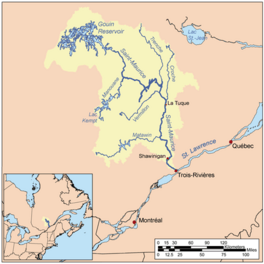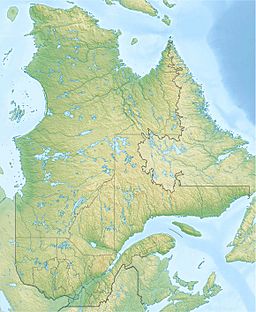Adolphe-Poisson Bay facts for kids
Quick facts for kids Adolphe-Poisson Bay |
|
|---|---|

Watershed of Saint-Maurice River
|
|
| Location | La Tuque |
| Coordinates | 48°27′02″N 75°24′14″W / 48.45056°N 75.40389°W |
| Type | Baie of dam |
| Primary inflows |
|
| Primary outflows | Hanotaux Bay, Du Mâle Lake |
| Basin countries | Canada |
| Max. length | 15.2 kilometres (9.4 mi) |
| Max. width | 3.2 kilometres (2.0 mi) |
| Surface elevation | 402 metres (1,319 ft) |
The Adolphe-Poisson Bay is a bay with fresh water. It's found in Quebec, Canada, near the town of La Tuque. It's on the southwest side of the huge Gouin Reservoir.
This bay is mostly in an area called Poisson Township. A small part, near a big island at the bay's opening, is in Hanotaux Township.
People mostly visit this area for fun activities like fishing or boating. Cutting down trees (forestry) is another important activity.
A forest road, R1009, runs along the west side of the bay. This road helps people get to the lower Flapjack River and parts of Bignell Creek and Bureau Lake. Road R1009 connects to Route 404, which is near the Canadian National Railway.
The surface of Adolphe-Poisson Bay is usually frozen from mid-November to the end of April. It's generally safe to travel on the ice from early December to late March.
Discovering Adolphe-Poisson Bay's Location
The Adolphe-Poisson Bay is at the western edge of the Gouin Reservoir's water system. This means it's where water flows into the reservoir.
Here are some of the main water bodies near Adolphe-Poisson Bay:
- North side: Saveney Lake, Gouin Reservoir, Du Mâle Lake, Hanotaux Bay, Plamondon Creek.
- East side: Mattawa Bay, Saraana Bay, Bureau Lake (South Bay), Oskélanéo River.
- South side: Bignell Creek, Flapjack River, Tamarac River, Clova River.
- West side: Lake of the Poète, Mégiscane River, Brécourt Lake, Suzie River, Pascagama Lake.
Adolphe-Poisson Bay is about 15.2 kilometres (9.4 mi) long, stretching from north to south. A large island, about 5.8 kilometres (3.6 mi) long, blocks the bay's opening. The water flows around this island: about 5.0 kilometres (3.1 mi) to the south and 6.1 kilometres (3.8 mi) to the north.
On the north side of this island, the water from Adolphe-Poisson Bay mixes with water from Hanotaux Bay. Then, the current flows southeast into Du Mâle Lake.
Adolphe-Poisson Bay gets its water mainly from:
- Saveney Lake (from the north).
- Bignell Creek (which flows into a bay in the south).
- Lake of the Poète through Piciw Minikanan Bay. There's a dam at the mouth of Lake of the Poète. This dam helps send water from the Suzie River and the upper Mégiscane River into the Gouin Reservoir through Adolphe-Poisson Bay.
The mouth, or opening, of Adolphe-Poisson Bay is located:
- 12.3 kilometres (7.6 mi) northeast of the canal from Lake of the Poète.
- 11.3 kilometres (7.0 mi) northeast of the mouth of Bignell Creek.
- 35.3 kilometres (21.9 mi) southwest of the village of Obedjiwan, which is on the north shore of Gouin Reservoir.
- 92.6 kilometres (57.5 mi) southwest of Gouin Dam.
- 131.7 kilometres (81.8 mi) northwest of the village of Wemotaci (on the north shore of the Saint-Maurice River).
- 223 kilometres (139 mi) northwest of downtown La Tuque.
- 317 kilometres (197 mi) northwest of where the Saint-Maurice River meets the St. Lawrence River at Trois-Rivières.
From the mouth of Adolphe-Poisson Bay, the water flows for about 119.2 kilometres (74.1 mi) until it reaches the Gouin Dam. Here's how the water travels:
- First, it flows 37.3 kilometres (23.2 mi) northeast across the western part of the Gouin Reservoir, including Du Mâle Lake, south of Obedjiwan.
- Then, it flows 81.9 kilometres (50.9 mi) to the east, crossing Marmette Lake. After that, it goes southeast through Brochu Lake and then east through Kikendatch Bay until it reaches the Gouin Dam.
From the Gouin Dam, the water continues to flow along the Saint-Maurice River all the way to Trois-Rivières.
The Name: Adolphe-Poisson Bay
The name of this bay honors Adolphe Poisson (1849-1922). He was born in Gentilly, Quebec, which is now part of Bécancour.
Adolphe Poisson became a lawyer in Quebec in 1873. He worked as an official in Arthabaska (now part of Victoriaville).
Poisson was also a writer. He published poems and stories in different newspapers. He released four collections of French poetry:
- "Chants canadiens à l'occasion du 24 juin 1880" (English: "Canadian songs on the occasion of June 24, 1880") (1880)
- "Heures perdues" (English: "Hours lost") (1894)
- "Sous les pins" (English: "Under the Pines") (1902)
- "Chants du soir" (English: "Evening Songs") (1917)
A special plaque was put up in Victoriaville to remember him.
The name "Baie Adolphe-Poisson" became official on March 10, 1970. This was decided by the Commission de toponymie du Québec, which is the group in charge of naming places in Quebec.


